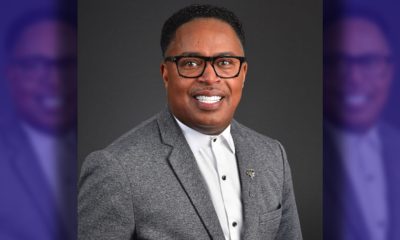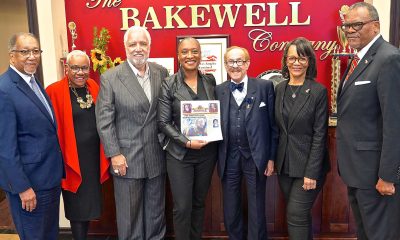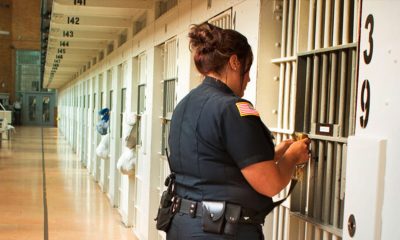#NNPA BlackPress
Wells Fargo sponsors Taste of Soul’s “Small Business Owner Giveaway”
LOS ANGELES SENTINEL — “I think ultimately we just want to inject some kind of capital into a small business because any amount of money when your a small business definitely impacts something whether it’s buying supplies or allowing you to buy more inventory,” said Wells Fargo Branch Manager Mario Holton.
By Faith Petrie, Contributing Writer
Amidst the bustling activities the 14th Annual Taste of Soul Family Festival summoned, Wells Fargo Branch Manager Mario Holton was preparing to do what he proclaimed “the coolest thing I’ve experienced thus far.”
That “cool thing” was the duty to present Yolanda Woodard, Next Generation Youth Television & Film Academy founder and chairwoman, with a check for $500. The bank located on Crenshaw and Stocker sponsored Taste of Soul’s Small Business Owner Giveaway in an effort to support local businesses in the area.
“We really wanted to empower the small businesses in the community,” Holton said. “We could have had a booth at Taste of Soul and did free giveaways but we felt like [the giveaway] was a lot more impactful because we already have a huge presence in this community.”
With three years as branch manager and four and a half years total working at Wells Fargo under his belt, Holton has witnessed numerous Taste of Soul events. In the past, participation by Wells Fargo could be seen in the form of classic spin-the-wheel booths and even the appearance of the Wells Fargo stagecoach. This year, the bank wanted to directly make a change in someone’s life.
“We felt it would be a lot more impactful if we actually gave money to a small business owner in the community and invested in the local community versus just having something there just to be seen,” Holton said.
Woodard, the giveaway recipient also wants to make an impact in a different way. Along with her partner Nicholas Jeffrey Moon, Woodard has created an academy aimed at inserting film programs into disadvantaged student’s lives.
“My whole life of being here in California, I have identified that South Central and East Los Angeles, our youth middle school and high schools, really don’t have an extensive film program the way the schools in the valley have,” Woodard said.
With a goal of opening in 2021, the academy will train young children of color in 33 departments of the film industry spanning anywhere between costumes to production managing and place students in actual productions to get direct work experience.
“It’s just my heart to train our children and just make sure that they’re given knowledge at a young [age] and it keeps them off of the streets if they decide to come to a program and they have hope, a real program that they get certified training working in the industry,’” Woodard said.
To Holton, the giveaway is a way for Wells Fargo to give businesses a push in the right direction to start their business.
“I think ultimately we just want to inject some kind of capital into a small business because any amount of money when your a small business definitely impacts something whether it’s buying supplies or allowing you to buy more inventory,” Holton said.
With the money, Woodard and Moon plan to open a bank account for the academy as well as fund a grant writer to gain additional funding. Being awarded the money meant “unity” to Woodard, a semblance of community within a larger scale.
“The love of Taste of Soul saying we support this community as a family, we support all business owners as a family, we have love for all business owners where none of them are going to be left behind,” Woodard said. “They have love for a business owner just like your parents would have or just like your family would have, that’s what’s needed for people to be successful, that’s what’s needed for our youth to be successful you have to have enough love in your heart to transfer a skill.”
For more information regarding resources for starting a business visit https://wellsfargoworks.com/.
The post Wells Fargo sponsors Taste of Soul’s “Small Business Owner Giveaway” appeared first on Los Angeles Sentinel.
#NNPA BlackPress
LIVE! — ASK ALMA — TUES. 5.30.23 7PM EST
This week, guest host Leah Farmer King and her panel share tips and advice to reader mail. Leah and the panel, along with the …
The post LIVE! — ASK ALMA — TUES. 5.30.23 7PM EST first appeared on BlackPressUSA.

This week, guest host Leah Farmer King and her panel share tips and advice to reader mail. Leah and the panel, along with the …
The post LIVE! — ASK ALMA — TUES. 5.30.23 7PM EST first appeared on BlackPressUSA.
#NNPA BlackPress
LIVE! — ASK ALMA! — TUES. 1.9.24 7 PM EST
HAPPY NEW YEAR! Welcome back for our first show of the year! This week, Alma and her panel answer viewer mail. As always …
The post LIVE! — ASK ALMA! — TUES. 1.9.24 7 PM EST first appeared on BlackPressUSA.
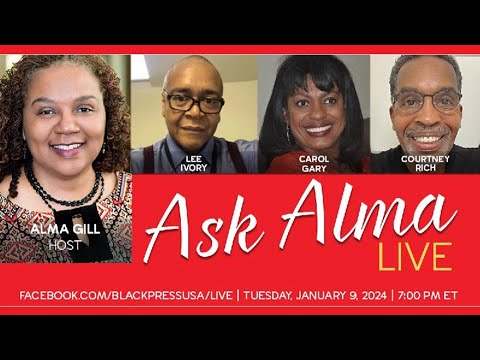
HAPPY NEW YEAR! Welcome back for our first show of the year! This week, Alma and her panel answer viewer mail. As always …
The post LIVE! — ASK ALMA! — TUES. 1.9.24 7 PM EST first appeared on BlackPressUSA.
#NNPA BlackPress
LIVE! — ASK ALMA! — TUES. 1.30.24 7PM EST
Think you’re the only one with problems? Each week, NNPA advice columnist Alma Gill, along with her panel of guest advisors …
The post LIVE! — ASK ALMA! — TUES. 1.30.24 7PM EST first appeared on BlackPressUSA.

Think you’re the only one with problems? Each week, NNPA advice columnist Alma Gill, along with her panel of guest advisors …
The post LIVE! — ASK ALMA! — TUES. 1.30.24 7PM EST first appeared on BlackPressUSA.
-

 Community3 weeks ago
Community3 weeks agoFinancial Assistance Bill for Descendants of Enslaved Persons to Help Them Purchase, Own, or Maintain a Home
-

 City Government6 days ago
City Government6 days agoCourt Throws Out Law That Allowed Californians to Build Duplexes, Triplexes and RDUs on Their Properties
-

 Activism2 weeks ago
Activism2 weeks agoOakland Post: Week of April 24 – 30, 2024
-

 Business3 weeks ago
Business3 weeks agoV.P. Kamala Harris: Americans With Criminal Records Will Soon Be Eligible for SBA Loans
-

 Activism4 weeks ago
Activism4 weeks agoOakland Post: Week of April 10 – 16, 2024
-

 Community3 weeks ago
Community3 weeks agoAG Bonta Says Oakland School Leaders Should Comply with State Laws to Avoid ‘Disparate Harm’ When Closing or Merging Schools
-
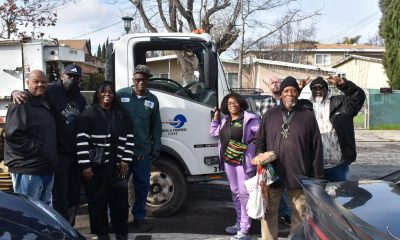
 Community3 weeks ago
Community3 weeks agoRichmond Nonprofit Helps Ex-Felons Get Back on Their Feet
-

 Community3 weeks ago
Community3 weeks agoOakland WNBA Player to be Inducted Into Hall of Fame



